panorama

4
Page 5
Fur Page 8
Winter 2023 Bird Anatomy Page
Wild Food for Native Birds
Adaptable
HELEN BOOMSMA Executive Director
The winter season is here! Enjoy this time of cold-weather activity by taking a brisk hike on our trails, traversing the calming forests, wetlands, and prairies to view winter wildlife.
In this issue of Panorama, discover essential food sources for birds in winter: fruits that include nuts, berries, and more. Learn about some native species of fruit-bearing shrubs and trees to plant in your yard to attract these birds when it is cold outside. Read about the winter changes to the fur of three local mammals. View detailed features of bird anatomy through an enticing graphic and discover the amazing potential to observe key species of birds on a hike at the Center. Learn about how Schlitz Audubon brings the wonder of the natural world to a diverse group of early learners.
We are now accepting applications for the 20th school year of our Nature Preschool, one of the first in the nation when it opened in 2003. Today we have four unique outdoor classrooms that are filled with engaging opportunities for children aged 3-5 to learn, play, and explore. Students also experience the joys of nature-inspired activities in our traditional classroom settings. We now also offer two K-4 Nuthatch classes that are almost entirely outdoors using an innovative “forest classroom” model. You and your little ones can explore nature together even before they are preschool age with Audubon Babies, designed for children 6-24 months, as well as Hand-in-Hand for children 2-3 years old! Visit our website to learn more!
In the midst of winter, we’re busy getting ready for summer! Our 2023 Summer Camp calendar and registration will be posted in mid-January. We’ll have camps for kids of all ages running from June 12 - August 11.
This season, enjoy all that the Center has to offer. Take part in guided nature hikes led by our expert naturalists, including to the Lake Michigan shoreline and through our varied habitats. Learn about birds, trees, ecology, and more. Sign your family up for Art in Snow to try a creative activity using snow as a medium. Watch a virtual presentation by ornithologist Tim Birkhead, author of Birds and Us: A 12,000-year History from Cave Art to Conservation. Join us in March at the Center to hear Dan Egan, author of Death and Life of the Great Lakes, talk about his new book, The Devil’s Element: Phosphorus and a World Out of Balance. The end of the season brings our Maple Sugar Time! program, where attendees learn how maple sap turns into syrup! Visit our website calendar for program details and registration.
Wintertime at Schlitz Audubon is packed with fun and learning. Enjoy our nature-inspired programs or experience the crisp air from the trails while hiking in our beautiful landscape.
Welcome
Carrie Nichols | Fiduciary Management, Inc.

COVER PHOTO A Cedar Waxwing catching a berry.
Admission
FREE admission to Members
Adults: $8 | Youth: $5 (ages 3 — 17) 1111 East Brown Deer Road | Milwaukee, WI 414-352-2880 | www.schlitzaudubon.org
Hours
Monday - Sunday | 8:30am-5:00pm
BOARD OF DIRECTORS
Officers
Shane Delsman President
Evan Kirkstein Treasurer Benjamin T. Pavlik Secretary
Barbie Brennan Nelson VP-Development John Schaub VP-Governance Directors
Renee M. Clair Heidi Dondlinger Amy Giuffre
Therese Gripentrog Jonathan T. Luljak Carrie Nichols Leia C. Olsen Jeff Rusinow
Lindsay Stevens
Past Presidents
John H. Kopmeier, Jr. Philip R. Smith Dennis L. Fisher
Terrence K. Knudsen Thomas J. McCutcheon Thomas B. Fitzgerald Randolph H. Dean Stephen F. Geimer Thomas J. Drought David K. Hoover John S. McGregor
Margarete R. Harvey Timothy J. Gerend John Grunau Aliah Berman
Director Emeritus Dorothy K. Vallier (1910-2013)
CREDITS FOR PANORAMA
Director of Marketing & Communications
Nancy Quinn
Creative Lead | Design & Photography
Zoe Finney
Editing | Select Writing Craig Mattson
Schlitz Audubon is an independent, locally supported partner of the National Audubon Society.
www.schlitzaudubon.org
WELCOME Winter 2023 |
2
to our new board member!
Discover the stillness of the winter season
MICHELLE ALLISON Adult Programs Manager
While walking the winter trails, calm and stillness permeate the landscape in contrast to the flurry of animal activity observed in other seasons. This quiet time offers a unique opportunity for birding. As you begin your morning walk, scan the treetops in the ravines for unusual dark shapes. Wild Turkeys roost in trees overnight in small groups. Witness their morning routine of taking a short flight to the forest floor to begin foraging.
The meandering trails of the Central Wetlands Loop pass through woodlands, wetlands, and prairies alive with birds. The transitional area between habitat types, called an ecotone, attracts a variety of bird species. Watch for flocks that gather during winter like Eastern Bluebirds, American Robins, and Cedar Waxwings. Some winter birds only make an appearance at the Center when food becomes scarce further north. Be on the lookout for less frequent visitors like Common Redpolls and White-winged Crossbills.
Enjoy a walk on the Lake Terrace Trail to view a variety of ducks on Lake Michigan. At first glance the ducks look like small black dots floating in the water. A pair of binoculars or a spotting scope will reveal the details necessary to identify the species. Greater Scaup, Common Goldeneye, Bufflehead, and Red-breasted Merganser may form rafts of hundreds of individuals floating in the waves. These “diving ducks” feed in deeper water offshore and disappear under the surface as they search for food.
Watch the sky above the lake for Bald Eagles soaring overhead. Bald Eagle populations are increasing across the state, so sightings are more common than they used to be. Lake Michigan provides eagles with plenty of fish to eat during winter. The woodlands along the Lake Terrace are a great habitat to look for other raptors like Red-tailed Hawks, Cooper’s Hawks, Great Horned Owls, and Eastern Screech Owls. Though not considered raptors, Northern Shrikes are predatory birds about the same size as robins. These songbirds have a habit of leaving small rodents and birds impaled on thorns to save as food later.
Some of the best winter birding can be found inside the Great Hall, watching our bird feeders. After your hike, grab a cup of coffee or cocoa, a bench near the window, and witness bird behavior up close. Black-capped Chickadees dart in to pick up a seed, then carry it away to eat at a different perch. They will even stash seeds in hiding places to save for later. American Goldfinches and Pine Siskins perch for long stretches of time on the thistle feeder, devouring seeds. Northern Cardinals provide a splash of bright red color as they enjoy some black oil sunflower seeds. Lookalike species, Downy and Hairy Woodpeckers, go straight for the suet feeder. Can you tell them apart by the Hairy’s larger size and longer bill? Look under the feeder for ground foragers like the American Tree Sparrow, Song Sparrow, and Dark-eyed Junco. If you can’t make it to the Center, you can view the birds at our feeder cams from your own home!
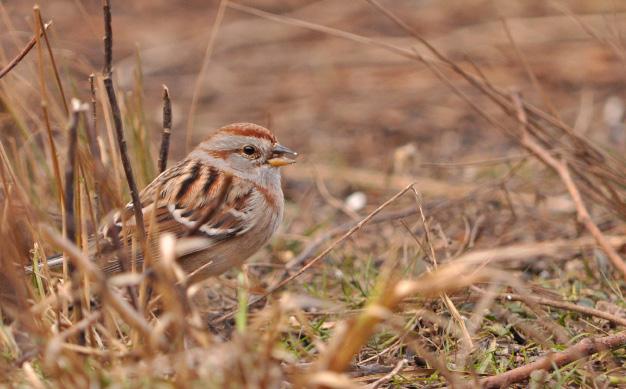
SEASONAL SIGHTINGS
3 Winter 2023 | www.schlitzaudubon.org
American Tree Sparrow eating under the feeders.
Crest
Can also be called a crown. The Cedar Waxwing has a subdued crest.

Basic Bird Anatomy
Nape
Feathers on the back of the neck.
Mask
Not all birds have a mask. They may have a supercilium (eyebrow) instead, or neither!
Beak
Also called a bill. The beak has evolved into a variety shapes depending on diet.
Throat
Primaries
Breast
Belly
Tarsus
The birds feet. The skin covering the feet is called podotheca and is scaly and hardened.
EDUCATION 4 Winter 2023 | www.schlitzaudubon.org
Helpful Field Marks to Learn, Featuring the Cedar Waxwing
Undertail Coverts
Stiff outer feathers. Tail Secondaries Stiff inner feathers. Rump
Zoe Finney | Creative Lead
for Wild Food
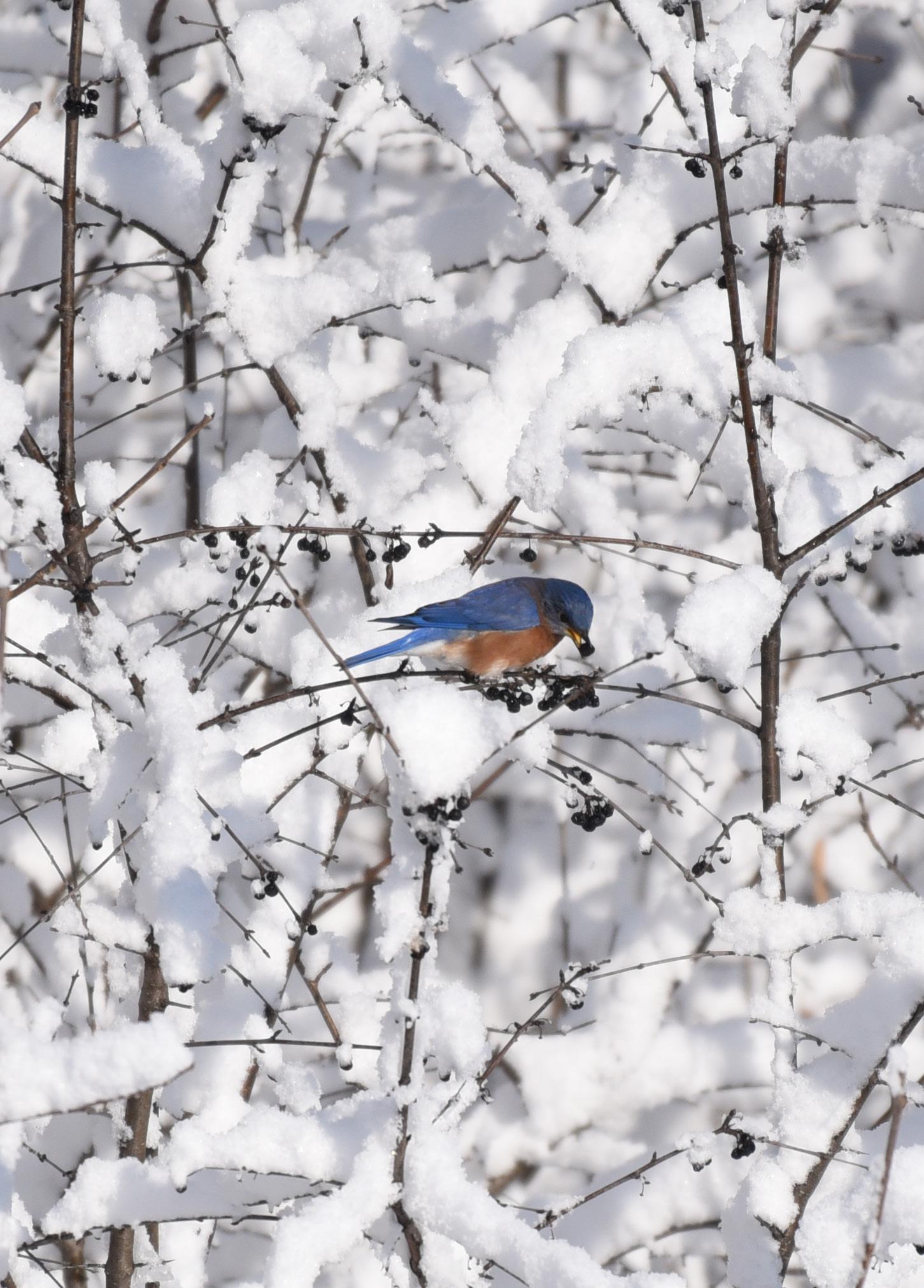
FEATURE Winter 2023 | www.schlitzaudubon.org 5
CRAIG MATTSON Communications Specialist
With contributions from Michelle Allison, Sandy Manning and Drew Shuster
Winter Birds
hile the fruits of plants, including large trees, small trees, and shrubs, provide birds with nutrition throughout the year, these food sources are essential to birds in winter. Food becomes scarce in the absence of warm-weather insects, a major source of nutrition. Many birds migrate south to be near a reliable supply of insects, but for those that overwinter in the northern hemisphere, fruits (seeds, nuts and nutlets, cones, and berries) are often plentiful.
THE RELATIONSHIP BETWEEN BIRDS AND FRUIT
There is an especially useful ecological relationship between birds and plants that bear fruit. Trees and shrubs produce fruit and berries to help disperse their seeds. They utilize birds, who are attracted to fruit that tastes good and who eat and spread the seeds. The seeds have a tough seed coat, which helps them remain viable while moving through the digestive system. When the fruit and seeds pass through the birds’ digestive tract, they are fertilized and scarified, and then dropped away from the parent plant, ready to germinate in spring. Some fruiting shrubs and tree species may even require their seeds to go through the digestive track of a bird to complete the reproductive cycle.
All flowering seed plants produce fruit, but with varying calorie and nutrition levels. The more calories a food has, usually the more sought after it is. Competition for food is high among birds, and desirable fruits are eaten to depletion earlier in the season, leaving less calorie dense food as the only obtainable option. Birds will not hesitate to eat this less nutritious food when they need it.
These foods grow at various times of the year, and many plants hold onto their fruit through the winter months. These fruits and berries are important to many species of Wisconsin’s overwintering birds. American Robins and Eastern Bluebirds form flocks of mixed species that move to where food is throughout the season. The Black-capped Chickadee, Northern Cardinal, Song Sparrow, and Downy Woodpecker are dependent on Wisconsin’s winter fruits. Goldfinches eat the seeds of coneflowers, which is why it is good to leave them standing after the growing season. The Cedar Waxwing, whose diet is mostly fruits through all seasons, is known to feast on berries throughout winter. Interestingly, it even eats berries that have fermented, causing the bird to become intoxicated!
PLANTING TREES AND SHRUBS
Birds in the wild rely on these fruits; planting them will attract birds to your yard while helping to feed them. It takes planning to choose the best species for your yard’s conditions. If you wish to help birds in winter, think about planting a diverse group of tree and shrub species, as they will bear fruit at various times and will provide a spectrum of calorie counts. There will always be a supply that is ready to eat, bringing more birds to your yard throughout the winter.
In addition to diversity, there are other considerations. Choose native plants, which are species that existed naturally in an area before European settlement. These plants are adapted to the local climate, soils, and precipitation. They co-evolved with local species, providing food that possesses the right size, availability, and calorie levels. Natives also provide shelter from the elements.
Other characteristics you might consider include the plant’s soil preferences, light preferences, showiness, hardiness, size, and size of its fruit, which should be small enough to feed birds. Visit a botanical garden or arboretum to see what the mature plant will look like. Consider the following suggestions and visit your local nursery for the best individualized advice.
LARGE TREES
Among large trees, three excellent choices for homeowners are oak, hackberry, and evergreens, such as juniper. Oak trees ( Quercus ) attract attention from many birds because their nuts are very nutritious. Choose the species that are native to Wisconsin, all of which provide acorns. Birds that eat acorns include Northern Flicker, Red-headed Woodpecker, Blue Jay, and others.
Hackberry ( Celtis occidentalis ), a deciduous tree with light colored wood, produces small nutlets that turn orange red to dark purple in autumn that are eaten by as many as 24 bird species through the winter. It is especially liked by Northern Flicker, Northern Mockingbird, Swainson’s Thrush, and Northern Cardinal. It’s a great street tree, so if your municipality offers to plant one in your yard’s parkway, take it.
Junipers ( Juniperus ) are hardy evergreens that produce seed bearing cones on the female plants. They come in a variety of different heights and are extremely hardy. Juniperus virginiana grows primarily in southern Wisconsin, and 54 species are known to eat its fruit, including Cedar Waxwing, Northern Mockingbird, Brown Thrasher, and Gray Catbird.
SMALL TREES
Numerous species of serviceberry ( Amelanchier ) grow as small trees or large shrubs. Their summer fruit, a red to purple berry-like pome which is nearly black at maturity in June, is attractive to fruit eating birds like American Robins and Cedar Waxwings.
Another small tree that birds like is the crabapple ( Malus ). The crabapple is smaller than other apples but is otherwise
FEATURE 6 Winter 2023 | www.schlitzaudubon.org
W
the same fruit. The persistent, bright red crabapple fruit will stay on the trees until birds locate it in late fall and winter and is especially liked by American Robins.
SHRUB SPECIES
Viburnums (Viburnum) include highbush cranberry, nannyberry, and several other native species. They produce drupes, which provide nutrition with plums, cherries, and other wild fruits. Nannyberry (V. lentago) fruits in fall, and the winter’s light red buds and can feed Gray Catbird, American Robin, Eastern Bluebird, and Cedar Waxwing, producing a sought-after food with high nutrition and calorie counts. Highbush cranberry (V. trilobum) is a late fruit often remaining on the plant through most of the winter as well. These fruits are bitter and are eaten after being frozen, when they are more desirable and often when nothing else is available.
Chokeberry (Aronia) is a deciduous shrub. It is often used as a backup option when food becomes scarce. The small, dark purple fruits on these plants are very astringent and offer less calories, protein, and other nutrients. They are still extremely useful to birds.
Rose (Rosa) is a beautiful shrub whose fruit is variable, with some species producing large showy hips favored by many birds. Single flowers attract more pollinators than the many petaled double hybrids, producing more fruit. One example is the prairie wild rose (R. arkansana), whose rose hips feed more than 38 species in late fall and early winter, including Northern Cardinal and Brown Thrasher. Rose is one of the most common yard plants and will produce its often-ornamental rosehips if growers
don’t deadhead the plants. Plant single flower shrub roses, such as Frau Dagmar Hartopp Rose, instead of multi-flora rose, as the latter are invasive in Wisconsin.
WINTER FRUIT FOR BIRDS AT THE CENTER

The Center’s conservation team creates management plans with bird conservation in mind, and it includes planting and maintaining shrubs and trees that possess fruits that birds desire. In the West Meadows, where invasive woody plants are removed using brush mowing, the team has mapped areas of native shrubs. Beginning in 2017, the team created conservation areas that leave these shrubs intact, including nannyberries and dogwoods, which are then utilized by birds for food.
In our Hardwood Swamp, the team plants various species including hackberry, oaks, Aronia, winterberry, and cherry species. Several berry plants that help birds are grown at the Center, such as gooseberries, blackberries, and currants. The currants have no thorns and are a great species to plant in your yard.
Visit the West Meadows, Hardwood Swamp, and areas within the North Ravine restoration area to see our native fruiting plants in winter. If you have native plants in your yard, a beneficial practice is to leave them standing when they are through growing for the season. These remnants will provide a place to perch and offer seeds to winter birds, allowing you to experience the thrill of seeing numerous bird species visit your yard throughout the season.
FEATURE 7 Winter 2023 | www.schlitzaudubon.org
Cedar Waxwing eating berries in December.
The Adaptable Fur of Mammals
CASSIE RINCON Family Programs Manager
In the frigid winter months, how do animals survive? Reptiles and amphibians brumate all winter long, sleeping through the harshest of freezing weather, while many species of birds migrate south in search of food and water. However, not all animals can sleep or fly away. For mammals that stay active all winter long, a key adaptation to their survival is their fur.
Although the word fur typically used for non-human mammals, we are referring to hair, which all mammals, including humans, have. All hair is made from a protein called keratin, but there are three types of hair with different purposes. The first, vibrissae, is designed to help an animal sense their surroundings, like whiskers on a cat. The second, ground hair, helps with thermoregulation. Finally, the guard hair is meant to protect the ground hair and skin from the outside elements.
As the seasons change in Wisconsin, the fur of a few mammals also goes through a change. One of our most common mammals, the white-tailed deer, has this change twice a year. In summer, their fur is red in color with short guard hair and no ground hair. Even though there are twice as many guard hairs in their summer fur than there are in their winter fur, without the ground hair, there is much more air flow to keep the deer cool during the hottest days. The guard hair mainly protects the deer from the sun as well as from bugs that would want to bite them.
Once the weather cools off, the deer grow their winter coat, which contains a thick, woolly layer of ground hair and long guard hair. The ground hairs are soft and twist around to create pockets of air close to the skin, making insulation. The guard hairs are hollow, which not only adds an extra layer of insulation, but also protects the underfur from cold, wet snow. Besides a textural change in their fur, there is also a change in color. The winter fur is gray to dark brown, which absorbs more sunlight and helps keep the deer warm.
Another animal that changes their fur color for winter is
the weasel, of which there are three types in Wisconsin. This animal has a more dramatic change in color, which not only helps it hide from their prey, but more importantly helps them escape from their predators! In summer, they have a dark brown coat with a white to pale yellow stomach, which helps them blend in with the forest floor. As winter approaches with the promise of snow, the weasels will shed their brown summer coat and start growing a white winter coat.
However, not all the fur on their body goes through a change. The weasels have a black tip of fur at the end of their tail to help distract predators. If there is an owl or a hawk that is hunting the weasel, the predators are more likely to see the black tip of the tail as the weasel is moving. Once this predator dives down for their prey, they could capture the black tip which would just be a small amount of fur, while the rest of the creature escapes. On the other hand, the weasel easily switches roles to become the predator by camouflaging in its surroundings and sneaking up on its prey, including another active Wisconsin mammal, the muskrat.
The muskrat is a semi-aquatic creature that has many predators, and to escape it swims away, even when there is ice covering the ponds. Since it uses this defense yearround, it doesn’t need to change its fur. To keep themselves from freezing in the water, most of their body is covered with densely packed ground hair and waterproof guard hair. Their feet and tail, which are not covered in fur, go through a process called regional heterothermia, which keeps those parts cool to conserve energy. This combination is essential to their survival as they escape predators and forage for food under the ice.
Though all mammals have some form of fur, Wisconsin mammals have fur with many unique attributes to help them survive in winter. Whether it’s hollow hair, waterproof hair, or changing the color of their hair, their fur will help them survive until the warmth of spring.
EDUCATION Winter 2023 | www.schlitzaudubon.org
8
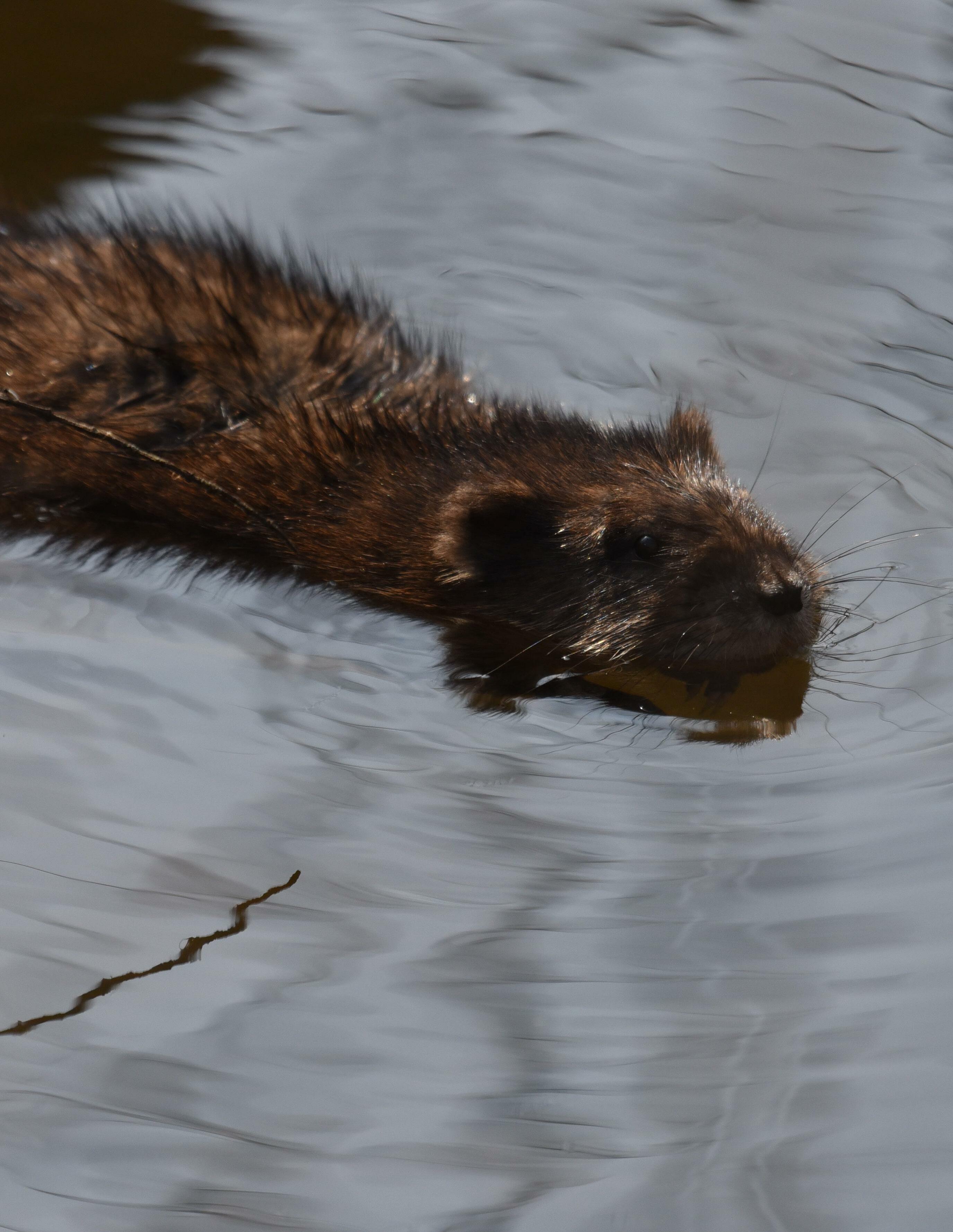
EDUCATION 9 Winter 2023 | www.schlitzaudubon.org
Inclusive Nature Experiences for Early Learners
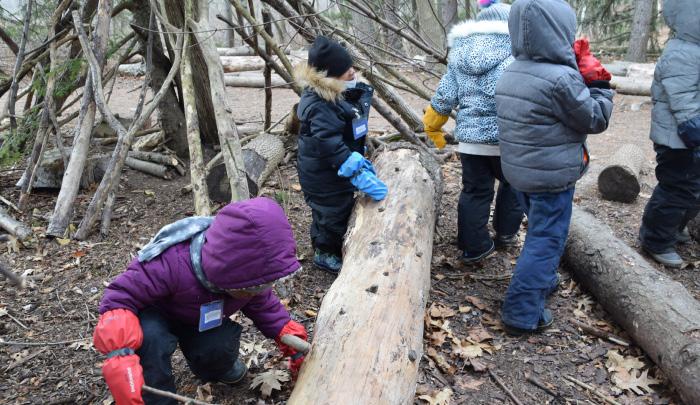 CARRIE BECKER Director of Development
CARRIE BECKER Director of Development
Splashing through mud puddles, catching frogs in a pond, tasting the sweetness of maple sap straight from the tree: such moments can be the basis of life-long, happy memories. In our increasingly urbanized society, however, many children never get the opportunity to experience the simple joys that time spent immersed in nature can bring. Through the Early Childhood Education Urban Outreach Program, a unique partnership with two Milwaukee schools, Malaika Early Learning Center and Next Door Milwaukee, Schlitz Audubon is seeking to change this paradigm by providing up to 150 children each year with recurrent, once-monthly nature education experiences.
Since 2003, Schlitz Audubon has featured an on-site preschool to encourage children to become comfortable in nature at an early age, which helps build lifelong connections with the environment. It's important to us that these critical programs are available to all students, especially children from economically challenged neighborhoods. Thanks to tremendous support from the donor community, the Urban Outreach Program was started in 2008 to help bridge this gap. Today, thanks to funders like the Herzfeld Foundation and Bader Philanthropies, the program is celebrating 15 years of serving the most vulnerable children in our community.
The Urban Outreach Program is a two-pronged model through which students enjoy free monthly field trip visits to the Center
during the school year, as well as regular visits from a Schlitz Audubon Early Childhood Educator right in their classrooms. Animal Ambassadors, such as Boxy, an eastern box turtle, or Severus, a western fox snake, also frequently visit with students. Onsite, our nature-focused curriculum includes outdoor discovery of Schlitz Audubon Nature Center’s diverse habitats, nature science exploration, beginning STEM concepts, dramatic play, and more.
In January, students are treated to what may be the best program of the year, when the Center’s raptor team presents a special program featuring our birds of prey: think Otis the majestic Peregrine Falcon, or Willow the Saw-whet Owl, a pint-sized way to inspire environmentalism in any young heart.
Beyond these structured activities, perhaps the most impactful part of our program is simply exposing children to the natural world and giving them opportunities to develop their own personal connections to nature. Onsite at Schlitz Audubon, maximum emphasis is placed on learning opportunities that can be facilitated outdoors, based upon tremendous positive feedback from students and teachers. Here students learn in the best possible way - they climb on logs, search for insects, dig for worms, hike the trails, splash in puddles, and play in the snow. They begin to develop a sense of place, an understanding of how the world around them works, and what we hope to be a lifelong love of nature sparked by happy memories.
10 DEVELOPMENT Winter 2023 | www.schlitzaudubon.org
Children in the Urban Outreach Program playing in an outdoor classroom.
Thank You Milwaukee Tool
In Memory Of In Honor Of
Shirley Baxter Wetter Anonymous
Bonnie Behee-Semler
Robert Amich
Nancy H. Chenery Susan Rebers
James Connelly
Susie Apple
William & Heidi Bartlett
Robert & Edith DuPuy Ernst & Christiane Endres
Stacey & Marty Henne Mary & Ted Kellner
Maryglen & Robert Kieckhefer Mark & Beth Leuck
Eleanor Seaman
Matthew Waite
LuAnne Ehr
Special thanks to Milwaukee Tool for providing Schlitz Audubon with an entire “wish list” worth of power tools and other materials to help facilitate the many construction projects continually taking place at the Center.
Our facilities and maintenance team put these tools to immediate use last year, and the results are plentiful: the beautiful new accessible boardwalks of the Central Wetlands Loop, the magical treehouse play structure in the Secret Forest preschool outdoor classroom, and the new custom-built animal ambassador carts in the Great Hall are just a few powerful examples of this donation at work.
Thanks to Milwaukee Tool, Schlitz Audubon’s facilities staff and volunteers have access to top-of-the-line equipment — from chainsaws to batteries — that makes their work more efficient and fun.

The Don Ehr Family Steven & Connie Ehr
LuAnne & Dick Ehr Liz Ehr
Bryn Miller-Kashik Bill & Karen Curran
Gordy Petersen Helen Davis & The Juffers
Frederick R. Ruenzel Kathy Brand & Cathy Regner Jody A. Heilbronner
Gretchen Shiparski Fran & Ray Broude
Kathryn Mross Lisa Peck
Jacqueline A. Slater June Bitney & Suzanne Jessen Kari Slater
Gordon & Kathryn Terry Bruce & Ann Kurtz
Peggy Ann Ward Timothy & Kathryn Collins
Barbara Becker
Andrew & Kelly Becker
Carrie & Jeff Becker
Steve Becker
Colleen Conway & John Heyer
Anonymous
Lisa & Ron Hopson
Dave & Tracy De Angelis
Aurelia Hunt
Andrew & Catherine Hunt
Jon Knopp Nancy Levin
Caroline Miller & Evan Fischer Brian Miller
Raptor Sponsorships
Athena – Barn Owl
In Honor of Jennifer Syverson Robert Syverson
In Memory of Nancy Carter
Marie Squire, Tiffany Scheible & Caitlin Nicoletto
Loki – American Crow
In Honor of Strange Bird Immersive Bradley Winkler
Sky Walker – Red-tailed Hawk
In Memory of James Nowicki Tom & Mary Frank
Willow – Northern Saw-whet Owl Christine Sedelnick
In Honor of Andy Hron Matthew Hron
General Raptor Support Erwin Gross Dorothy Zajac
DEVELOPMENT 11 Winter 2023 | www.schlitzaudubon.org
Gifts listed in this issue were received between 07/01/22 – 09/30/22
1111 East Brown Deer Road Milwaukee, Wisconsin 53217
U.S. Postage PAID Milwaukee, WI Permit No. 4168
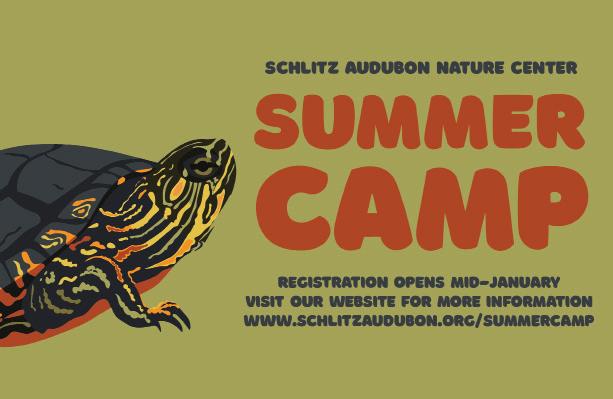 Schlitz Audubon Nature Center
WINTER 2023 PANORAMA
Schlitz Audubon Nature Center
WINTER 2023 PANORAMA








 CARRIE BECKER Director of Development
CARRIE BECKER Director of Development

 Schlitz Audubon Nature Center
WINTER 2023 PANORAMA
Schlitz Audubon Nature Center
WINTER 2023 PANORAMA